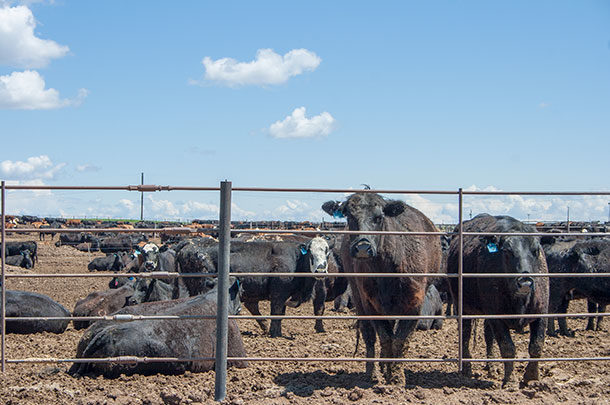The incidence is variable depending upon type of cattle, relative energy of the diet, and potential for clinical and subclinical acidosis, environmental changes and frankly, unknown factors.
LA develops when bacteria, typically, but not exclusively, Fusobacterium necrophorum (a gram-negative species) invade the liver. Other bacteria including Trueperella pyogenes (gram-positive) can also cause the abscesses. The liver “walls off” these bacteria, forming a visible abscess.
One of the difficulties in controlling liver abscesses is lack of outward signs, and the results only reveal themselves at slaughter and with reduced production efficiency for that lot of cattle. While the symptoms may go unobserved, the economic losses can be significant.
At slaughter, affected liver parts will be condemned. In severe cases, the entire liver and even adjoined organs and tissue can be condemned as well. Additionally, cattle suffering from LA may have reduced performance through poorer growth rate, decreased feed efficiency and reduced carcass weights.
Using antibiotics
Severe liver abscesses may represent a loss of $52 per case. Estimated losses to the beef industry vary, with many estimates between $30 million and $60 million.
Tylosin has traditionally been the antibiotic of choice to reduce liver abscesses. In recent years, there has been an increase in liver abscess occurrence despite use of tylosin. There has been a suggestion that tylosin may have lost some effectiveness due to microbial adaptation. However, a study found no difference in resistance between samples from cattle having LA versus those that did not.
Regardless of effectiveness, use of tylosin may become increasingly restricted in agriculture given the antibiotic’s role in human medicine. The Veterinary Feed Directive (VFD) now requires a veterinarian to prescribe the use of tylosin. This has led to a search for determining contributing factors that lead to LA and alternative technologies that may help.
One possible solution is use of diets with less grain and more forage. Economically, this is not an effective solution due to reduced growth rates and increased net feed costs. There have been a couple of attempts at developing vaccines with varied success. They appear to be more effective in cattle with a lower risk of LA than when the risk is greater. Kansas State University was awarded a patent for a vaccine that may have improved efficacy in the rumen area, but this may not affect bacteria entering further down the digestive tract.
Blocking the leak
Another approach is to look toward methods and products that improve gut health to help prevent the absorption of pathogenic bacteria. Traditionally, liver abscesses were thought to develop because of injury or breaks in the rumen wall, allowing bacteria to enter. There is evidence, however, that bacteria invading via breaks in the rumen wall can also enter at the small intestine, and the latter may represent a major source of bacteria leading to liver abscesses.
“Leaky gut” can result from heat stress, reducing the barrier to systemic infection. Heat stress can also result in changes in feed dry matter intake that may lead to acidosis, another contributing factor to liver abscesses. Furthermore, both heat and cold stress can result in increased oxidative conditions, affecting gut and liver health and the ability of these tissues to repair themselves.
Other factors that can lead to leaky gut are the mycotoxin group of trichothecenes. The most common of this group are vomitoxin and T2, both of which can affect the gut lining. These and many other mycotoxins can have negative effects on liver health and limit the liver’s ability to heal. The trichothecenes are of particular interest as they reduce the tight junction between cells in the intestinal wall, allowing bacteria through the intestinal barrier.
These mycotoxins can also result in proteins leaking out into the gut, which can cause overgrowth of Clostridium perfringens. C. perfringens produces exotoxins that further damage the gut lining. It has been documented in other species that animals consuming trichothecene-contaminated diets have an increased absorption of gram-negative bacteria such as salmonella.
Mycotoxin levels in grain have increased over the years due primarily to a change in crop production, i.e., increased no-till. Plant breeders have improved some plant tolerance, but the plants often do this by incorporating mycotoxin into cell walls which will be released when the crop is consumed by animals.
Generally speaking, ruminants are not affected as much by mycotoxins as are monogastric animals. This is due to breakdown of some mycotoxins in the rumen, but many mycotoxins are not significantly reduced in the rumen. Additionally, the relative fast passage rate for feedlot cattle reduce the opportunity for breakdown in the rumen. Fumonisin is a mycotoxin that has been prevalent the past couple of years.
Fumonisin contamination in dairy cattle can affect production but does not seem to have a great effect in cattle well-adapted to the feed. However, it may still have negative effects in cattle under stress, such as receiving cattle and very poor lot conditions. Given the variability in mycotoxin contamination and the variability in LA, it may represent one of the unknown factors in the development of LA.
The oil alternative
One non-antibiotic support for liver health may be the incorporation of phytogenic compounds such as essential oils. Many of these products have anti-inflammatory and antioxidant properties that can result in greater gut health. The compound limonene, found in citrus oils and caraway, has antimicrobial effects against the F. necrophorum bacterium found in the majority of LA. During laboratory tests in its purified form, it has very similar effects as tylosin at the same concentrations and may represent a future help in reducing LA.
Researchers are also looking at the potential of yeast and yeast cell wall products to reduce LA. Yeast cell wall components have a demonstrated ability to bind to gram-negative bacteria, such as those found in LA. Additionally, yeast products may modify rumen fermentation to reduce the deleterious bacteria in the first place.
In summary: Liver abscesses remain a problem in modern feedlot operations. We know the main species of bacteria involved, but unknown contributing factors including weather conditions and potential mycotoxin contamination have not been fully explored.
The potential loss of tylosin to the industry will cause increased focus on other ways to help reduce and manage liver abscesses. It is unlikely that any single product currently under research will provide a “complete solution.” However, a combination of natural products including phytogenics and yeasts may yet provide an economic method to mitigate the negative effects associated with modern feed practices and liver abscesses. ![]()
PHOTO: It’s difficult to identify liver abscess in cattle because of a lack of outward signs until slaughter, or reduced efficiency. Staff photo.
References omitted but are available upon request. Click here to email an editor.

-
Bryan Miller
- Technical Support Manager
- Biomin
- Email Bryan Miller








